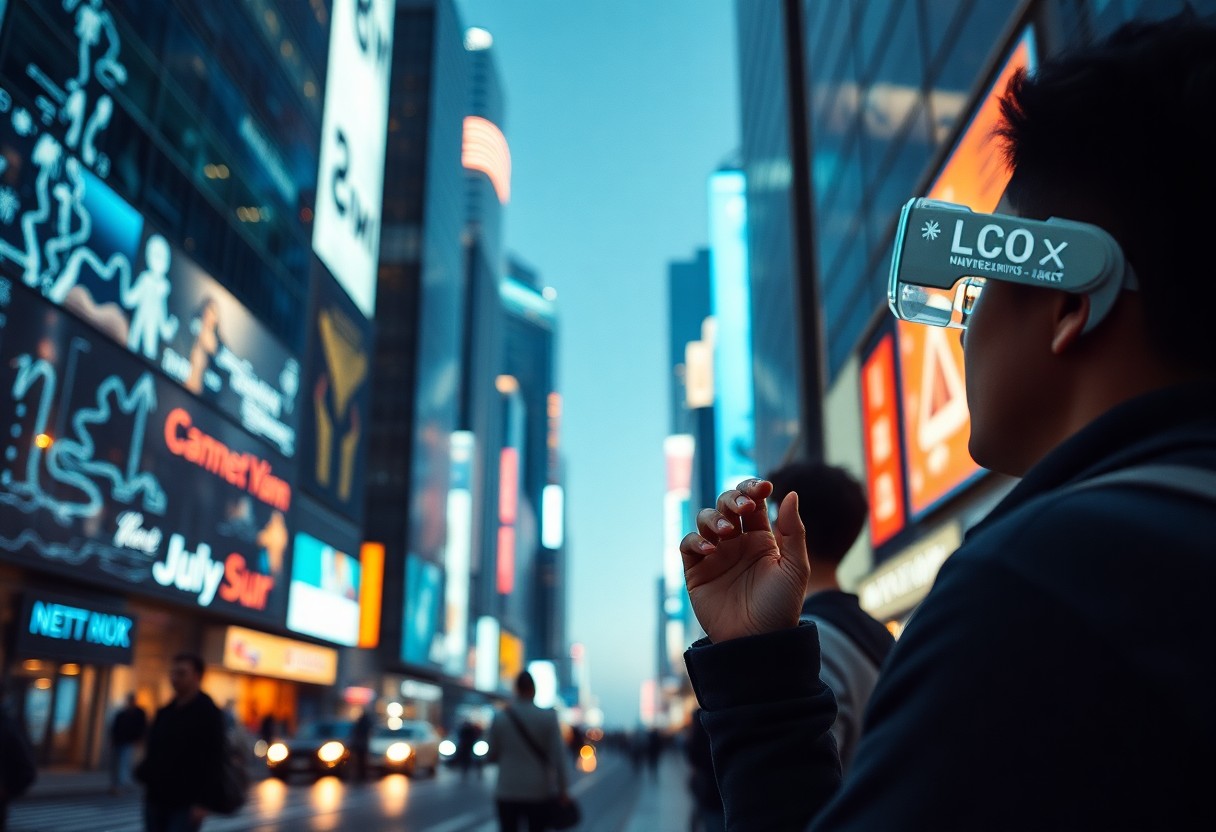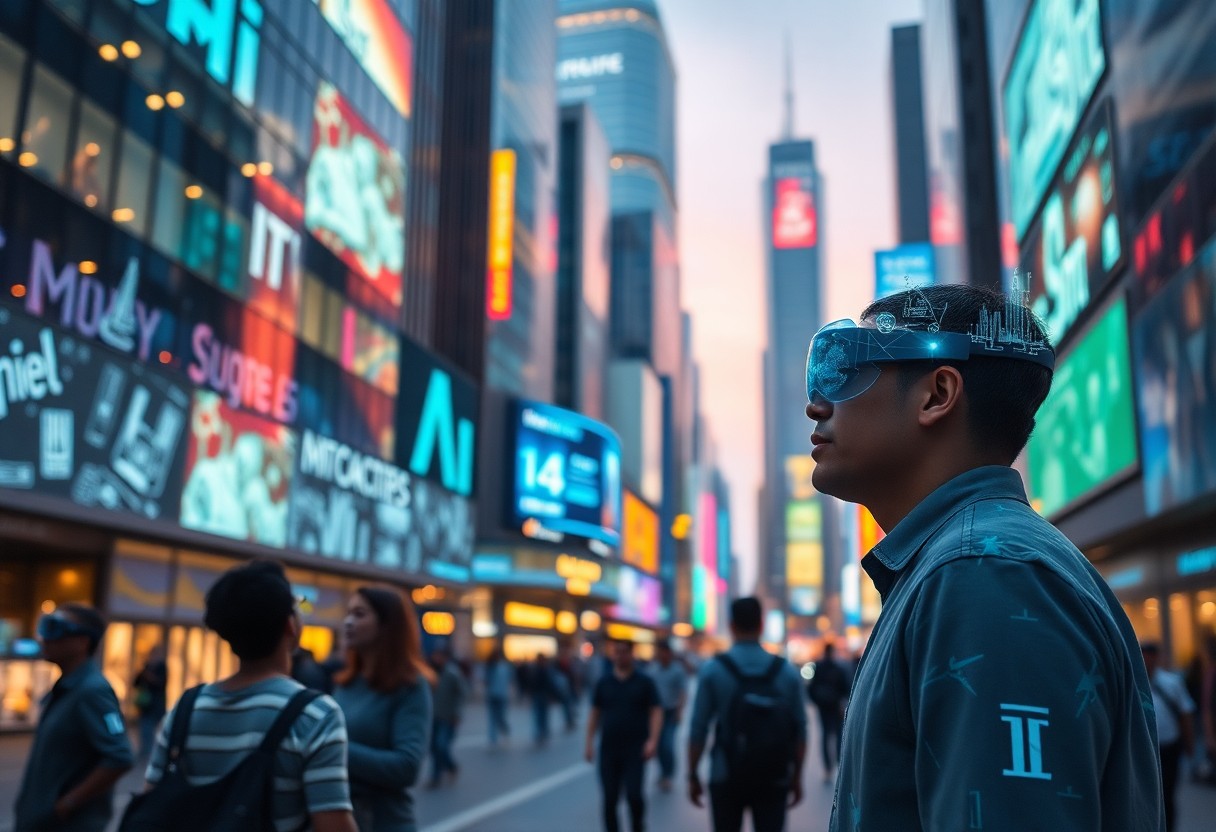Future advancements in augmented reality (AR) are set to revolutionize the way you interact with the world around you. As you examine this fascinating realm, you’ll discover how AR technologies enhance education, provide unique experiential marketing opportunities, and even improve healthcare practices. However, it’s crucial to consider the potential risks associated with privacy and data security that could arise as this technology proliferates. Join us as we explore the most intriguing facts about AR and how they may directly influence your daily life moving forward.
Key Takeaways:
- Enhanced Education: Augmented Reality (AR) can transform educational experiences by providing interactive learning environments that make complex subjects more understandable and engaging.
- Improved Retail Experiences: AR can revolutionize the shopping experience by allowing customers to visualize products in their own environment before making a purchase, ultimately driving sales and customer satisfaction.
- Health Care Innovation: In the medical field, AR can assist doctors in surgery by overlaying critical information onto their field of view, enhancing precision and patient outcomes.
The Evolution of Augmented Reality
Your understanding of augmented reality (AR) is grounded in its dynamic evolution, which has transformed the way we interact with the world around us. By tracing its journey from simple visual overlays to a sophisticated blend of digital and physical environments, you can appreciate how AR continues to shape various industries and enhance everyday experiences.
Historical Milestones
Among the notable milestones in the history of augmented reality are the development of the first AR systems in the 1960s and 70s, including Ivan Sutherland’s “Sword of Damocles” and commercial applications in the late 1990s, such as ARToolKit. Each of these achievements laid the groundwork for the immersive technologies we engage with today, illustrating how AR has advanced over decades.
Technological Advancements
Around the turn of the century, AR technology saw significant leaps with the advent of smartphones and powerful computer graphics, making it more accessible and user-friendly. This wave of innovation paved the way for applications in gaming, education, and healthcare, and you can see how these advancements have redefined your interactions with digital content.
At this juncture, the integration of artificial intelligence and machine learning has played a transformative role in enhancing the capabilities of augmented reality. This intersection allows for more intuitive and interactive experiences, providing you with real-time data and analytics to assist decision-making. However, it’s important to consider the implications of such technologies, as they may raise concerns regarding privacy and data security. Balancing the positive impact of AR, like improving education and health outcomes, against potential risks is imperative for harnessing its full potential in your future.
1. Enhanced education through immersive, interactive learning experiences.
2. Retail transformation via virtual try-ons and personalized shopping.
3. Improved healthcare with real-time data visualization in surgeries.
4. Urban planning benefits from visualizing infrastructure changes virtually.
5. Entertainment evolution with immersive gaming and storytelling experiences.
6. Enhanced navigation systems for safer and efficient travel.

Current Applications of Augmented Reality
Clearly, augmented reality (AR) is transforming various sectors by offering innovative solutions in real-time. Industries such as gaming, education, and healthcare are leveraging AR technology to enhance user engagement, efficiency, and accessibility. Businesses are recognizing the potential of AR to create immersive experiences, ultimately shaping our daily lives and future interactions.
Gaming and Entertainment
At the forefront of augmented reality, gaming and entertainment have embraced AR to provide unparalleled experiences. Games like Pokémon GO have shown how AR can blend the virtual world with your surroundings, allowing you to interact with digital elements directly in real life. This trend is redefining how you perceive and enjoy entertainment.
Education and Training
About AR offers innovative methods for education and training, making learning more immersive and interactive. Through AR, you can visualize complex concepts, engaging with content in ways that textbooks simply cannot provide. This technology fosters a deeper understanding of subjects, enhancing both individual and collaborative learning experiences.
With augmented reality, you can interact with 3D models and scenarios that promote hands-on learning. Imagine exploring the solar system by visualizing planets in your classroom or practicing surgical procedures in a simulated environment. This interactive approach not only makes learning more enjoyable but also equips you with the practical skills needed for real-life applications.
Healthcare Innovations
Along with education, AR is making waves in healthcare, enhancing patient care and medical training. Technologies like AR surgery assist surgeons by overlaying critical information during procedures, improving accuracy and safety. This integration empowers medical professionals to make precise decisions in real-time, ultimately benefiting patient outcomes.
Another fantastic aspect of AR innovations in healthcare is the potential for remote consultations. By allowing you to visualize medical information and receive guidance from specialists through AR platforms, access to quality care becomes more feasible, even in remote areas. This system not only streamlines the healthcare process but also fosters a more patient-centered approach, improving your overall experience.
Economic Impact of Augmented Reality
Many experts agree that augmented reality (AR) is set to revolutionize various industries, creating significant economic impact. From enhancing customer experiences in retail to streamlining operations in manufacturing, AR is poised to increase productivity and drive innovation. As your organization adopts AR technologies, you can expect to see improvements in efficiency and cost-effectiveness, ultimately contributing to a more robust economic landscape.
Market Growth and Projections
On a global scale, the augmented reality market is projected to grow at an impressive rate, with revenue expected to reach billions of dollars in the coming years. As you engage with this evolving technology, you can capitalize on new consumer trends and demands, allowing your business to stay ahead of the curve and maintain competitive advantage.
Job Creation and Industry Transformation
By embracing augmented reality, industries are experiencing transformation and new opportunities for job creation. This growing field demands skilled professionals who can develop, implement, and manage AR solutions across various sectors.
Plus, augmented reality is not only changing existing job roles but also creating entirely new positions you might not have thought were possible. With AR entering fields like education, healthcare, and retail, you will find opportunities for specialized developers, designers, and trainers who can harness this technology effectively. The increase in demand for skilled workers reflects a promising trend, where job opportunities multiply and your career prospects expand in tandem with this technological evolution.

Societal Implications of Augmented Reality
Unlike traditional technologies, augmented reality (AR) has the potential to reshape societal structures, influencing how you interact with your environment and each other. The integration of AR into everyday life can revolutionize industries from education to healthcare, enhancing learning experiences and providing real-time guidance. As you navigate these changes, it’s crucial to consider the broader societal impacts of integrating AR into your daily routines.
Enhancing Daily Life
Beside augmenting your understanding of the world around you, AR can simplify tasks and enhance your experience. Whether you are shopping, traveling, or engaging with art, AR applications bring layers of information and experiences directly to your field of vision, making daily activities more interactive and efficient.
Privacy and Ethical Considerations
Any new technology comes with its share of privacy concerns and ethical dilemmas. As AR devices become pervasive, you may find your personal data being collected more frequently, raising questions about who controls that information and how it’s used.
Augmented reality technologies can be double-edged swords. While they enhance your experiences, they also pose significant privacy risks. You may unknowingly share personal data as AR platforms gather information from your interactions. Furthermore, the potential for misuse of this data for surveillance or targeted advertising raises serious ethical concerns. Ensuring that you maintain control over your information while enjoying the benefits of AR will be crucial as these technologies evolve.
Future Trends in Augmented Reality
Despite the current fascination with augmented reality (AR), its future holds even more potential to transform everyday life. As technology continues to evolve, AR will likely become increasingly integrated into social interactions, education, and daily tasks. This innovation may redefine how you perceive the world around you, enhancing your experiences and interactions with digital information seamlessly blended into your physical environment.
Integrating AI and AR
At the intersection of artificial intelligence (AI) and augmented reality lies a fertile ground for innovation. This integration opens doors to personalized experiences, where AR can adapt in real-time based on your actions or preferences. Advanced algorithms will enable AR systems to recognize objects, provide contextual information, and even predict your needs, effectively enhancing your interaction with the world.
AR in Various Industries
Among the numerous applications of augmented reality, various industries are already experiencing its transformative impact. From healthcare to education and retail, AR technologies enhance training, facilitate remote assistance, and engage customers like never before.
To understand the impact of AR across industries, consider the healthcare sector, where AR can assist surgeons during operations, allowing them to visualize critical data on patients in real time. In education, AR creates immersive learning experiences, enabling you to explore complex subjects interactively. The retail industry utilizes AR to offer virtual try-ons and enhance customer engagement, creating compelling shopping experiences. As you explore these developments, keep an eye on the way AR reshapes your interactions and expectations in everyday tasks and sectors of interest.
Challenges and Limitations
Now, while augmented reality holds immense potential, it also faces several challenges and limitations that could hinder its widespread adoption. Issues such as technological barriers, user acceptance, and accessibility must be addressed to ensure AR can enhance your experiences effectively and integratively.
Technological Barriers
Along with the excitement of AR, there are significant technological obstacles that you must consider. Limitations in hardware performance, battery life, and processing power can restrict your ability to enjoy seamless AR experiences. Additionally, the lack of interoperability between AR applications can lead to a fragmented ecosystem that may frustrate users.
User Acceptance and Accessibility
Above all, user acceptance and accessibility are vital to the future of augmented reality. Many potential users may be hesitant to embrace new technology due to concerns about privacy, safety, or simply a lack of understanding about how AR can benefit them.
Plus, it is important to note that addressing accessibility directly impacts how users embrace AR in their daily lives. The technology needs to be designed with user-friendly interfaces that cater to diverse demographics, including those with disabilities. Additionally, considerations regarding privacy and security must be prioritized to ensure you feel safe while using AR applications. By focusing on creating an inclusive and secure environment, developers can foster greater trust and engagement, enabling you to fully appreciate the advantages that augmented reality can bring to your life.
Final Words
With this in mind, it’s evident that augmented reality holds immense potential to revolutionize various aspects of your life, from education and entertainment to healthcare and retail. As you explore the fascinating world of AR, consider how these intriguing facts could influence your daily experiences and professional engagements. To help you stay informed about evolving trends, check out The Future of Augmented Reality: Top Trends and …. Your understanding of AR today could shape your future interactions with this groundbreaking technology.
Q: How can augmented reality (AR) enhance education and learning experiences?
A: Augmented reality has the potential to revolutionize the educational sector by providing immersive learning experiences. By overlaying digital information onto real-world environments, AR can help students visualize complex concepts in subjects like science and mathematics. For instance, students can explore 3D models of the human anatomy or celestial bodies, allowing for a more interactive learning approach. Additionally, AR can facilitate remote learning through virtual classrooms, where students can engage with educators and peers in an augmented environment, making education more accessible and engaging.
Q: What role does augmented reality play in the retail industry?
A: Augmented reality is reshaping the retail landscape by enhancing the shopping experience for consumers. Retailers are leveraging AR to create virtual fitting rooms, allowing customers to try on clothes or accessories without physically wearing them. This technology not only improves customer satisfaction but also reduces the number of returns. Furthermore, AR can be used in store displays to provide customers with additional product information, reviews, and recommendations by simply scanning a product with their smartphones. This innovation is transforming how we shop, making it more interactive and informed.
Q: How might augmented reality influence our social interactions and communications in the future?
A: Augmented reality could significantly change how we interact socially by merging the physical and virtual worlds. With AR, people could enhance their social gatherings by sharing digital content, such as videos, games, or art, in real-time, fostering a deeper connection and collaborative experiences. Additionally, social media platforms are beginning to adopt AR features, allowing users to create and share augmented content. As these technologies advance, they could redefine how we perceive social interactions, making them more dynamic and engaging, transcending physical limitations.
Back/Home
